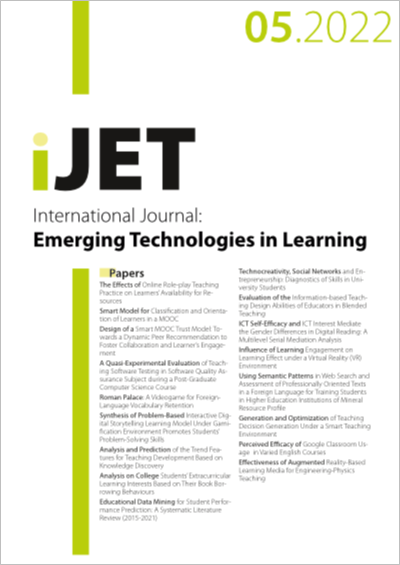Synthesis of Problem-Based Interactive Digital Storytelling Learning Model Under Gamification Environment Promotes Students’ Problem-Solving Skills
DOI:
https://doi.org/10.3991/ijet.v17i05.28181Keywords:
problem-based learning, digital storytelling, gamification, learning model, problem solving skills,Abstract
The aims of this study were to synthesize and evaluate the efficiency of problem-based interactive digital storytelling learning model under gamifi-cation environment for promoting students’ problem-solving skills. This study was divided into two phases, (i)develop learning model by studying research and related documents and (ii) assessing the appropriateness of the model by nine experts in computer and education using a focus group method. In this current study, show the learning model consisted of three main components: preparation, learning activities, and evaluation and there were four parts of the learning activities, which are: problem-based learning, reflection of learning, interactive digital storytelling, and gamification envi-ronment. The results show that the overall suitability assessment of the de-veloped learning model was averaged at 4.56 (S.D.= 0.60), being at the most appropriate level. These results lead to a conclusion that the developed problem-based interactive digital storytelling learning model under gamifi-cation environment can significantly promotes students’ problem-solving skills. This learning model is suitable and can be applied to develop desired learners' achievements and skills.
Downloads
Published
2022-03-14
How to Cite
Poonsawad, A., Srisomphan, J., & Sanrach, C. (2022). Synthesis of Problem-Based Interactive Digital Storytelling Learning Model Under Gamification Environment Promotes Students’ Problem-Solving Skills. International Journal of Emerging Technologies in Learning (iJET), 17(05), pp. 103–119. https://doi.org/10.3991/ijet.v17i05.28181
Issue
Section
Papers
License
Copyright (c) 2022 Akarapon Poonsawad, Jiraphan Srisomphan, Charun Sanrach

This work is licensed under a Creative Commons Attribution 4.0 International License.



